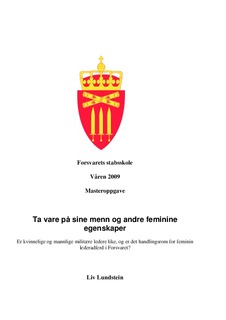| dc.description.abstract | The Armed Forces top the list of the most male-dominated sectors in Norway when it comes to the number of male and female leaders. The purpose of this study has been to find out if the military get increased addition of feminine characteristics through the women who seek military education and career. The main question to be addressed was: "Are female and male military leaders equal, and is there room for feminine leader behaviours in the armed forces?" I addressed the following hypotheses: Female and male military leaders are equal. There is a special type of women who choose the Armed Forces. There is limited room for feminine leader behaviours in the military.
The results of the study indicate that female military leaders are not equal to male military leaders, but the differences in their personality is a bit smaller than between the sexes in the reference group. There is not a special type of women who choose the Armed Forces, but they have a number of common features of more masculine character. There is limited room for feminine behaviours in military leadership, due to the early adaptation to the male-dominated culture. This shows that the Armed Forces only to a certain extent receive the feminine characteristics through the women who seek an education and career in the military. | en_US |
